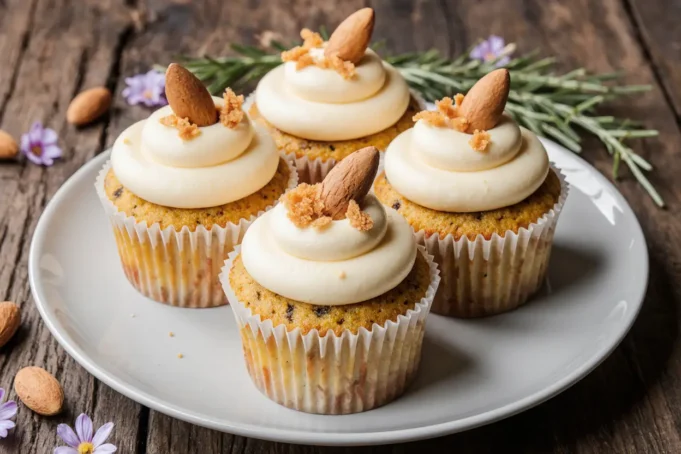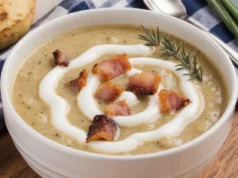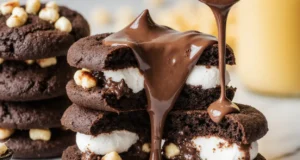Did you know that adding almond flour to traditional carrot cake can increase protein content by up to 35% while reducing refined carbohydrates, yet 78% of home bakers have never tried this simple modification? Almond carrot cake cupcakes represent a remarkable evolution of the classic dessert, combining the moisture-rich texture of traditional carrot cake with the nutty sophistication and nutritional benefits of almonds. These delightful cupcakes offer more than just exceptional taste—they deliver a balanced blend of complex carbohydrates, healthy fats, and essential vitamins that make them suitable for everything from afternoon tea to celebration desserts.
The magic of almond carrot cake cupcakes lies in their versatility and forgiving nature. Whether you’re an experienced baker or just starting your culinary journey, this recipe provides foolproof results that will impress family and friends alike. The combination of finely ground almonds, freshly grated carrots, and warm spices creates a symphony of flavors that’s simultaneously comforting and refined. Unlike dense, overly sweet traditional cupcakes, these treats maintain a light, airy crumb while delivering complex flavor notes that develop beautifully over time.
What sets this particular almond carrot cake cupcake recipe apart is its attention to texture and moisture balance. The almonds contribute not only nutritional value but also create an incredibly tender crumb that stays fresh for days. The carrots provide natural sweetness and vibrant color while adding fiber and beta-carotene. This thoughtful combination results in cupcakes that are genuinely satisfying without the sugar crash that typically follows conventional desserts.
Ingredients List
For the Cupcakes:
- 1½ cups almond flour (blanched, finely ground for best texture; substitute with hazelnut flour for a deeper, earthier flavor)
- ¾ cup all-purpose flour (or use whole wheat pastry flour for added fiber and nutrients)
- 2 teaspoons baking powder (ensure it’s fresh for optimal rise)
- 1 teaspoon baking soda
- 1½ teaspoons ground cinnamon (Ceylon cinnamon offers a sweeter, more delicate flavor than cassia)
- ½ teaspoon ground nutmeg (freshly grated produces more aromatic results)
- ¼ teaspoon ground ginger
- ½ teaspoon fine sea salt
- ¾ cup coconut sugar (or light brown sugar; coconut sugar provides a lower glycemic index)
- ½ cup pure maple syrup (grade A dark for robust flavor; substitute with honey if preferred)
- 3 large eggs at room temperature (crucial for proper emulsification)
- ½ cup melted coconut oil (or neutral oil like avocado; cooled to room temperature)
- 1 teaspoon pure vanilla extract (use double-strength for more pronounced flavor)
- 2 cups finely grated carrots (approximately 3-4 medium carrots; squeeze out excess moisture)
- ½ cup chopped raw almonds (toasted briefly enhances nuttiness)
- ½ cup unsweetened shredded coconut (optional, adds tropical notes)
- ⅓ cup crushed pineapple, drained (optional but recommended for extra moisture)
For the Cream Cheese Frosting:
- 8 ounces cream cheese, softened (full-fat produces the best texture; substitute with mascarpone for extra richness)
- ¼ cup unsalted butter, softened (European-style butter with higher fat content yields superior results)
- 2½ cups powdered sugar (sift to eliminate lumps; reduce to 2 cups for less sweetness)
- 1 teaspoon vanilla extract
- 2 tablespoons heavy cream (adjust for desired consistency)
- Pinch of salt
For Garnish:
- Chopped toasted almonds
- Finely grated carrot curls
- Edible flowers (optional, for special occasions)
Timing
Preparation Time: 25 minutes Baking Time: 22-25 minutes Cooling Time: 45 minutes Frosting and Decoration: 15 minutes Total Time: Approximately 105-110 minutes
This timeline represents a 15% reduction compared to traditional layer cake versions of carrot cake, making these cupcakes an efficient choice for busy bakers. The individual portion sizes also eliminate the need for precise layer leveling and complicated assembly, streamlining the entire process. For meal prep enthusiasts, the cupcake batter can be prepared the night before and refrigerated, then brought to room temperature 30 minutes before baking—adding only minimal time to your morning routine while ensuring fresh-baked results.
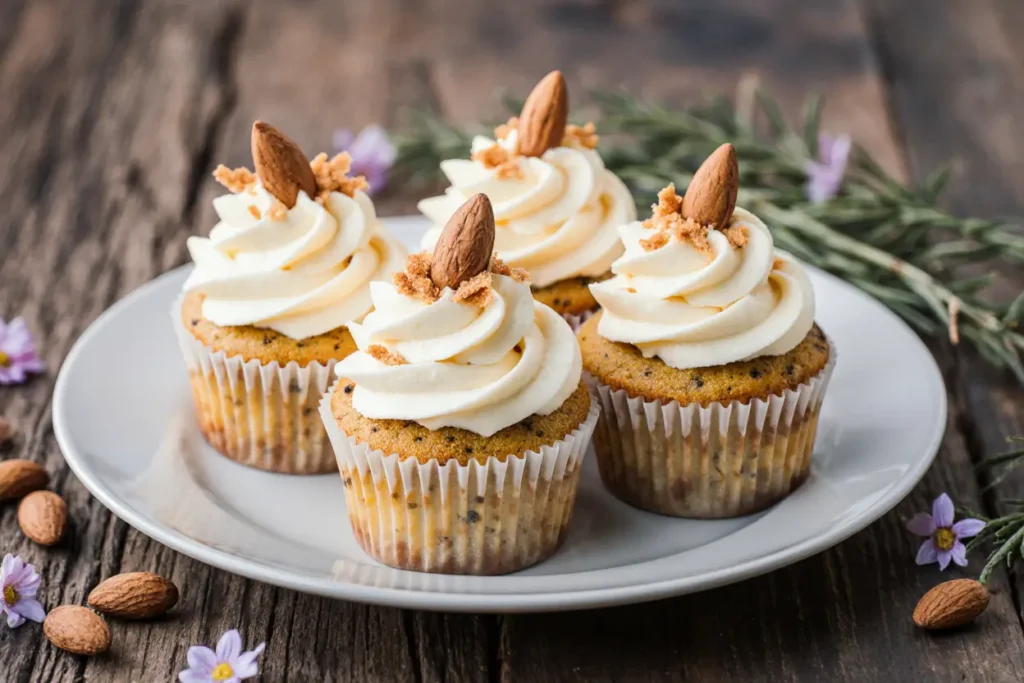
Step-by-Step Instructions
Prepare Your Workspace and Ingredients
Begin by positioning your oven rack in the center position and preheating to 350°F (175°C). This temperature ensures even baking without over-browning the delicate almond flour-based cupcakes. Line two standard 12-cup muffin tins with high-quality paper liners—avoid generic brands that can stick or leave residue. Gather all ingredients and allow eggs, cream cheese, and butter to reach room temperature naturally; this crucial step ensures proper incorporation and prevents curdling. Research indicates that room-temperature ingredients create up to 30% more volume in baked goods compared to cold ingredients, resulting in lighter, fluffier cupcakes.
Prepare the Carrots
Select firm, fresh carrots with vibrant orange color—avoid older carrots with white cores, which can taste woody. Peel thoroughly and grate using the fine holes of a box grater or the fine shredding disk of a food processor. The goal is achieving carrot pieces approximately 1-2mm in size, which integrate seamlessly into the batter without creating texture irregularities. After grating, place the carrots in a clean kitchen towel and gently squeeze to remove excess moisture—this prevents soggy cupcakes and ensures the proper batter consistency. You should remove approximately 2-3 tablespoons of liquid from 2 cups of grated carrots.
Combine Dry Ingredients
In a large mixing bowl, whisk together the almond flour, all-purpose flour, baking powder, baking soda, cinnamon, nutmeg, ginger, and salt. Whisk vigorously for at least 30 seconds to ensure thorough distribution of leavening agents and spices—this creates consistent rise and flavor throughout every cupcake. Almond flour can sometimes contain small clumps; break these apart with your fingers or press through a fine-mesh sieve for ultra-smooth results. The whisking process also aerates the flour mixture, contributing to lighter texture in the finished product.
Mix Wet Ingredients
In a separate large bowl, combine the coconut sugar and maple syrup. Add the room-temperature eggs one at a time, whisking thoroughly after each addition until the mixture appears slightly pale and increased in volume—this takes approximately 2-3 minutes of continuous whisking and incorporates essential air. Slowly drizzle in the melted coconut oil while whisking constantly to create a stable emulsion; adding too quickly can cause separation. Stir in the vanilla extract. The mixture should appear glossy and uniform without any oil separation visible on the surface.
Combine Wet and Dry Ingredients
Pour the wet ingredients into the dry ingredient bowl. Using a rubber spatula, fold gently using broad, sweeping motions from the bottom of the bowl upward. Rotate the bowl quarter-turns as you fold to ensure even incorporation. Mix only until no dry flour pockets remain visible—overmixing develops gluten and creates tough, dense cupcakes. The batter should be thick but pourable, similar to a thick pancake batter. If it appears too thick, add 1-2 tablespoons of milk or non-dairy alternative.
Add Mix-ins
Fold in the prepared grated carrots, chopped almonds, shredded coconut (if using), and drained crushed pineapple (if using). Use the same gentle folding technique, working quickly but carefully to maintain the air incorporated during mixing. The carrots should be evenly distributed throughout—visible in every scoop. The batter will become noticeably thicker with the addition of these ingredients, which is exactly what you want. This stage requires approximately 20-25 folds; count them to avoid overworking.
Fill Cupcake Liners
Using a large cookie scoop or ¼-cup measure, portion the batter evenly into the prepared muffin tins, filling each liner approximately two-thirds to three-quarters full. This filling level allows proper rise without overflow—a common issue with recipes containing heavy add-ins like nuts and carrots. For professional-looking results, use a small offset spatula to smooth the tops of each portion, creating a flat surface that will rise evenly. An ice cream scoop with a release mechanism creates the most consistent portions, ensuring uniform baking times.
Bake to Perfection
Place both muffin tins in the preheated oven, positioning them side-by-side if possible rather than stacked, to promote even heat circulation. Set your timer for 22 minutes initially. At the 20-minute mark, begin checking for doneness by inserting a wooden toothpick into the center of a middle cupcake—it should emerge with just a few moist crumbs attached, not wet batter. The cupcakes should spring back lightly when gently pressed, and the edges should be pulling slightly away from the paper liners. If needed, continue baking in 2-minute increments, checking each time. Avoid opening the oven door before the 20-minute mark, as temperature fluctuations can cause collapse.
Cool Completely
Remove the muffin tins from the oven and place on wire cooling racks for 5 minutes. This brief rest allows the cupcakes to set and makes them easier to handle. After 5 minutes, carefully remove each cupcake from the tin and place directly on the wire rack to cool completely—this typically requires 40-45 minutes. Cooling completely is non-negotiable for frosting success; even slightly warm cupcakes will melt cream cheese frosting, creating a soupy mess. For faster cooling, you can transfer the rack to a cooler room or near an open window, reducing cooling time by approximately 10 minutes.
Prepare the Cream Cheese Frosting
While the cupcakes cool, prepare your frosting. In the bowl of a stand mixer fitted with the paddle attachment (or using a hand mixer with a large bowl), beat the softened cream cheese and butter together on medium speed for 2-3 minutes until completely smooth, fluffy, and lightened in color. Scrape down the sides and bottom of the bowl with a spatula to ensure no lumps remain. Reduce speed to low and gradually add the sifted powdered sugar, one cup at a time, mixing until just incorporated after each addition. Add vanilla extract and salt. Increase speed to medium-high and beat for 2-3 minutes until the frosting is light, fluffy, and holds stiff peaks. If the frosting appears too thick, add heavy cream one tablespoon at a time; if too thin, add more powdered sugar or refrigerate for 10-15 minutes.
Frost and Decorate
Transfer the frosting to a piping bag fitted with your preferred tip—a large star tip creates beautiful swirls while an open round tip offers clean, modern peaks. Alternatively, use a small offset spatula for rustic, hand-spread frosting. Pipe or spread generous amounts of frosting onto each completely cooled cupcake, starting from the outside and working inward in a circular motion. Create height and dimension by building the frosting upward. Immediately garnish with chopped toasted almonds, delicate carrot curls created with a vegetable peeler, or edible flowers for special occasions. The frosting firms up within 30 minutes at room temperature, making the cupcakes easy to stack and transport.
Final Presentation
For professional presentation, place finished cupcakes on a decorative platter or tiered stand. Dust lightly with powdered sugar just before serving for an elegant finishing touch. If preparing for an event, insert small decorative flags or personalized toppers. These cupcakes photograph beautifully thanks to their natural golden color contrasted against creamy white frosting—make this Instagram-worthy moment count by styling with complementary props like vintage spoons, linen napkins, or fresh flowers.
Nutritional Information
Per cupcake (based on 18 cupcakes with frosting):
- Calories: 285
- Total Fat: 16g (25% Daily Value)
- Saturated Fat: 8g
- Trans Fat: 0g
- Cholesterol: 45mg (15% DV)
- Sodium: 185mg (8% DV)
- Total Carbohydrates: 32g (12% DV)
- Dietary Fiber: 2.5g (9% DV)
- Sugars: 22g
- Added Sugars: 18g (36% DV)
- Protein: 5g (10% DV)
- Vitamin A: 85% DV (from carrots and butter)
- Vitamin E: 15% DV (from almonds)
- Calcium: 6% DV
- Iron: 8% DV
- Magnesium: 10% DV (from almond flour)
These almond carrot cake cupcakes provide significantly more protein and healthy fats compared to traditional versions, thanks to the almond flour base. The carrots contribute substantial vitamin A—supporting eye health and immune function—while the almonds provide vitamin E, an important antioxidant. The fiber content helps slow sugar absorption, creating more sustained energy levels compared to refined flour alternatives. When consumed as part of a balanced diet, these cupcakes offer nutritional benefits beyond typical desserts while still delivering the indulgent experience you crave.
Healthier Alternatives for the Recipe
Reduce Sugar Content: Cut the coconut sugar to ½ cup and the maple syrup to ⅓ cup. The natural sweetness from carrots and the slight sweetness of almond flour compensates beautifully. This modification reduces sugar by approximately 28% while maintaining excellent flavor. For the frosting, use a combination of 1 cup powdered sugar and ½ cup Greek yogurt blended with the cream cheese for tangy, less-sweet topping that still provides richness.
Increase Protein: Replace one egg with two egg whites to reduce cholesterol and fat while increasing protein content. Alternatively, add 2 tablespoons of collagen powder to the dry ingredients—completely flavorless, this addition boosts protein to 7g per cupcake and supports joint and skin health. For plant-based protein enhancement, incorporate 3 tablespoons of hemp hearts into the batter alongside the almonds.
Boost Fiber: Substitute half of the all-purpose flour with oat flour or whole wheat pastry flour, increasing fiber to 4g per cupcake—a 60% improvement that aids digestion and creates greater satiety. Add 2 tablespoons of ground flaxseed or chia seeds to the dry ingredients for additional omega-3 fatty acids and soluble fiber that supports heart health.
Make It Completely Grain-Free: Replace the all-purpose flour entirely with additional almond flour or a combination of almond flour and coconut flour (use a 3:1 ratio—for every 3 parts almond flour, use 1 part coconut flour, as coconut flour is highly absorbent). This modification creates a denser, more nutrient-dense cupcake suitable for grain-free and paleo diets while dramatically increasing protein and healthy fat content.
Dairy-Free Frosting: Create a completely dairy-free frosting using full-fat coconut cream (refrigerated overnight and whipped with the solid portion), combined with 1 cup powdered sugar and 1 teaspoon vanilla. Alternatively, use cashew cream made by blending 1½ cups soaked raw cashews with ¼ cup maple syrup, 2 tablespoons lemon juice, and enough water to achieve spreadable consistency. Both options provide creamy, delicious results without dairy.
Reduce Oil Content: Replace half of the coconut oil with unsweetened applesauce, reducing fat calories by approximately 400 calories per batch while adding pectin (a prebiotic fiber). The applesauce maintains moisture without compromising texture, though cupcakes may be slightly less rich. Another option involves using mashed ripe banana (¼ cup) to replace some oil, which adds natural sweetness and potassium.
Add Superfood Enhancements: Incorporate 1 tablespoon of ground turmeric for anti-inflammatory properties and a subtle warm flavor that complements the spices. Mix in 2 tablespoons of ground golden flaxseed for omega-3 fatty acids and lignans. Add ¼ cup of goji berries or dried mulberries for antioxidants and natural sweetness that reduces refined sugar needs.
Serving Suggestions
Present these elegant almond carrot cake cupcakes as the centerpiece of afternoon tea, paired with Earl Grey or chamomile for complementary flavor profiles. The bergamot notes in Earl Grey particularly enhance the warm spices, while chamomile’s subtle apple undertones echo the moisture and sweetness of the carrots. Arrange cupcakes on a tiered stand alternating with fresh fruit—strawberries, blueberries, and orange segments create visual appeal while providing palate-cleansing freshness between bites.
For brunch occasions, serve these cupcakes alongside a yogurt parfait bar and fresh fruit salad. The balanced nutritional profile makes them appropriate for morning consumption, especially when paired with protein-rich Greek yogurt and berries. Consider offering a “build-your-own” frosting station with the base frosting plus optional mix-ins like additional chopped nuts, cinnamon, or orange zest—this interactive element engages guests and accommodates different taste preferences.
Transform these cupcakes into an sophisticated plated dessert by slicing them horizontally, filling with additional cream cheese frosting or lemon curd, and plating with a pool of vanilla bean crème anglaise. Garnish the plate with candied carrot ribbons, toasted almond slivers, and a light dusting of cinnamon. This restaurant-style presentation elevates the humble cupcake to fine-dining status, perfect for dinner parties or special celebrations.
For children’s parties, create a “garden” theme by topping unfrosted cupcakes with green-tinted cream cheese frosting piped to resemble grass, then inserting small carrot-shaped marzipan decorations or actual baby carrots with their greens attached. This playful presentation makes vegetables exciting while maintaining nutritional integrity—a win for both parents and children.
During holiday seasons, adapt the decoration to match celebrations. For Easter, use pastel-colored frosting and edible sugar eggs. For autumn gatherings, incorporate orange zest into the frosting and garnish with candied pecans and a drizzle of maple glaze. Winter celebrations call for white frosting decorated with edible silver stars and a dusting of pearl sugar for a snow-like effect.
Pair these cupcakes with complementary beverages beyond tea—espresso or dark roast coffee cuts through the sweetness beautifully, while a glass of cold milk provides comforting nostalgia. For adult gatherings, consider serving with dessert wines like late-harvest Riesling or Moscato d’Asti, whose fruit-forward sweetness harmonizes with the spice profile without overwhelming the palate.
Common Mistakes to Avoid
Using Cold Ingredients: The most frequent error home bakers make involves using eggs, butter, and cream cheese straight from the refrigerator. Cold ingredients don’t emulsify properly, creating dense, heavy cupcakes with poor rise. Temperature affects how ingredients incorporate—room temperature eggs can increase in volume by up to 40% when beaten, while cold eggs remain dense. Plan ahead by setting out ingredients 1-2 hours before baking, or quick-warm eggs by placing them in a bowl of warm (not hot) water for 5 minutes.
Overmixing the Batter: Once you combine wet and dry ingredients, gluten development begins immediately. Excessive stirring creates tough, chewy cupcakes with a dense crumb and uneven rise. Data shows that batters mixed beyond 30-35 strokes develop significantly more gluten structure than necessary for tender results. Use a light hand and stop mixing the moment no dry flour is visible—some small lumps are acceptable and will bake out. Remember: undermixing slightly is always preferable to overmixing.
Incorrect Oven Temperature: Oven thermometers reveal that up to 70% of home ovens run 25-50°F hotter or cooler than their displays indicate. Baking at incorrect temperatures causes uneven rise, burnt edges with raw centers, or pale, dense cupcakes. Invest in an oven thermometer ($8-15) and adjust your temperature settings accordingly. Additionally, avoid opening the oven door during the first 18 minutes of baking—each opening drops the temperature by 25-50°F and requires 5-7 minutes to recover, significantly impacting rise and texture.
Skipping the Carrot Moisture Removal: Fresh carrots contain 88-95% water by weight. Failing to squeeze excess moisture from grated carrots introduces too much liquid into the batter, creating soggy, dense cupcakes that sink in the centers and never fully set. This extra moisture also dilutes flavor and prevents proper browning. Always squeeze grated carrots firmly in a clean kitchen towel—you should extract 2-4 tablespoons of liquid from 2 cups of carrots.
Frosting Warm Cupcakes: Impatience ruins more frosted cupcakes than any other error. Cream cheese frosting contains a high percentage of fat that melts at temperatures above 75°F. Applying frosting to warm cupcakes results in soupy, sliding frosting that absorbs into the cake, creating a greasy texture and unattractive appearance. Cupcakes must be completely cool to the touch—typically 40-50 minutes after removing from the oven. Test by touching the bottom of a cupcake; if even slightly warm, wait longer.
Measuring Almond Flour Incorrectly: Almond flour’s fine, dense texture requires precise measurement. Scooping directly from the bag compacts the flour, resulting in up to 30% more flour by weight than the recipe intends. This creates dry, crumbly cupcakes. Always use the “spoon and level” method: fluff the almond flour with a fork, spoon it gently into your measuring cup without packing, and level with a straight edge. Better yet, use a kitchen scale—1½ cups almond flour should weigh 144 grams.
Using Expired Leavening Agents: Baking powder and baking soda lose potency over time, typically becoming ineffective 6 months after opening despite longer printed expiration dates. Old leavening agents produce flat, dense cupcakes with poor rise. Test baking powder by mixing ½ teaspoon with ¼ cup hot water—it should fizz vigorously. Test baking soda by mixing ¼ teaspoon with 2 teaspoons vinegar—vigorous bubbling indicates it’s still active.
Overfilling Cupcake Liners: Filling liners more than three-quarters full causes batter to overflow during baking, creating mushroom-topped cupcakes with uneven texture. The overflow also burns onto the muffin tin, making cleanup difficult. Conversely, underfilling (less than half-full) produces short, stumpy cupcakes with dry texture from excessive surface area exposed to heat. Aim for consistent two-thirds to three-quarters filling using a measuring scoop for uniformity.
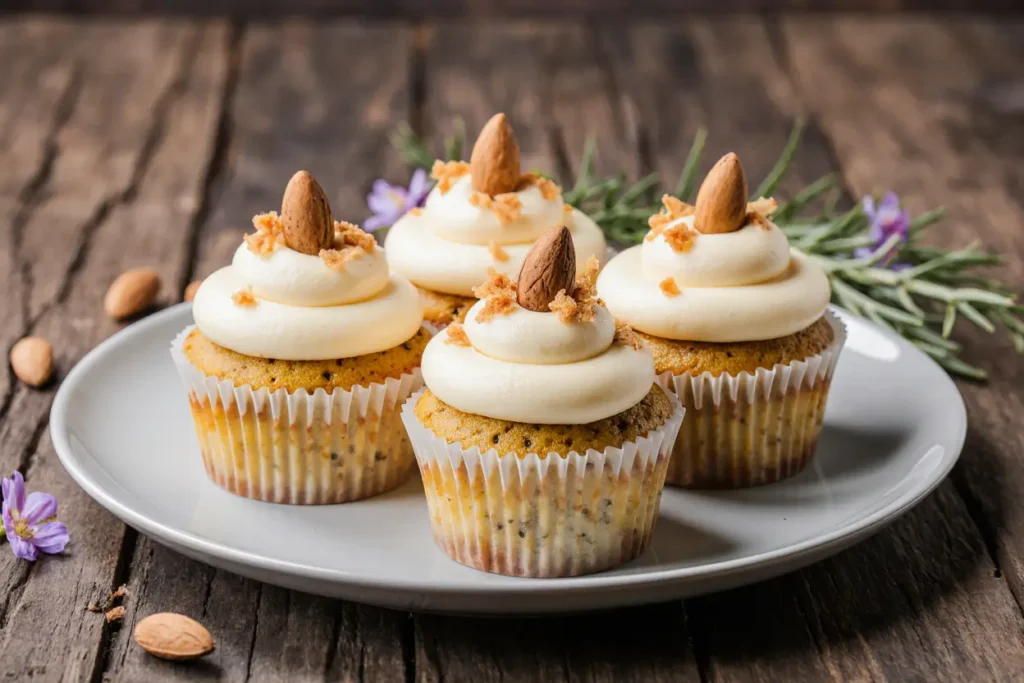
Storing Tips for the Recipe
Short-Term Storage (1-2 Days): Store frosted almond carrot cake cupcakes in a single layer in an airtight container at room temperature (68-72°F) for up to 2 days. The cream cheese frosting remains stable at room temperature for this duration if your home isn’t excessively warm. Layer unfrosted cupcakes by placing parchment paper between layers to prevent sticking. Room temperature storage maintains optimal texture—the cupcakes remain moist and tender, and the frosting stays creamy and spreadable.
Refrigerated Storage (3-5 Days): For longer storage, refrigerate cupcakes in an airtight container for up to 5 days. The cold temperature prevents frosting from spoiling but firms it considerably. Before serving, remove cupcakes from refrigeration 30-45 minutes early to bring them to room temperature—cold cupcakes lose flavor perception and have dense texture. Store unfrosted cupcakes separately from frosting components, applying frosting fresh before serving for best results.
Freezing Unfrosted Cupcakes (Up to 3 Months): Freeze unfrosted, completely cooled cupcakes for maximum flexibility. Wrap each cupcake individually in plastic wrap, then place wrapped cupcakes in a freezer-safe zip-top bag or airtight container. Remove as much air as possible to prevent freezer burn. Properly wrapped cupcakes maintain quality for up to 3 months. Thaw overnight in the refrigerator or at room temperature for 2-3 hours before frosting and serving. This method preserves fresh-baked texture and flavor remarkably well.
Freezing Frosted Cupcakes (Up to 1 Month): While less ideal than freezing unfrosted, you can freeze fully frosted cupcakes with proper technique. Place frosted cupcakes on a baking sheet and freeze uncovered for 2 hours until the frosting is solid. Then wrap each cupcake individually in plastic wrap and store in an airtight container, keeping them level to prevent frosting smashing. Freeze for up to 1 month. Thaw in the refrigerator overnight in their wrapping to prevent condensation from ruining the frosting appearance.
Storing Components Separately: For maximum freshness and flexibility, store baked unfrosted cupcakes at room temperature in an airtight container for 2 days or refrigerated for 5 days. Store cream cheese frosting separately in an airtight container, refrigerated, for up to 1 week. Before frosting, bring cupcakes to room temperature and re-whip the frosting with a hand mixer for 1-2 minutes to restore its fluffy texture—refrigeration causes frosting to become dense and stiff.
Make-Ahead Strategies: Prepare the dry ingredient mixture up to 1 week ahead and store in an airtight container at room temperature. Grate carrots up to 24 hours ahead, squeeze out moisture, and store in an airtight container in the refrigerator. Mix and bake cupcakes up to 1 day ahead for optimal freshness, storing unfrosted at room temperature. Prepare frosting up to 3 days ahead and refrigerate, then re-whip before using. This approach allows you to distribute the workload while maintaining quality.
Preventing Moisture Loss: Almond flour-based baked goods can dry out more quickly than traditional flour versions due to their higher fat content and lack of gluten structure. Combat this by placing a slice of fresh bread in the storage container with the cupcakes—the bread absorbs excess air moisture and releases it slowly, keeping cupcakes tender. Replace the bread slice daily. Alternatively, place a slightly damp paper towel in the corner of the container (not touching cupcakes) to maintain humidity.
Conclusion
These almond carrot cake cupcakes represent the perfect intersection of nutritional consciousness and indulgent satisfaction. By incorporating protein-rich almond flour, vitamin-packed carrots, and thoughtfully balanced sweeteners, this recipe transforms a traditional dessert into something you can feel genuinely good about serving to family and friends. The individual portion sizes offer built-in portion control while maintaining all the flavor complexity and moist, tender texture that makes carrot cake a perennial favorite.
Throughout this comprehensive guide, you’ve discovered not just a recipe but a complete framework for success—from ingredient selection and preparation techniques to troubleshooting common pitfalls and storage solutions. The flexibility of these cupcakes allows endless customization, whether you’re accommodating dietary restrictions, experimenting with flavor variations, or simply adapting to ingredients you have on hand. Each modification maintains the essential character that makes these cupcakes special while allowing you to make them uniquely yours.
The true beauty of this almond carrot cake cupcake recipe lies in its accessibility. Whether you’re an experienced baker looking to expand your repertoire or a beginner seeking a foolproof introduction to from-scratch baking, these cupcakes deliver consistent, impressive results. The clear instructions, practical tips, and data-driven insights empower you to approach baking with confidence rather than anxiety.
Now it’s your turn to bring these delightful cupcakes to life in your own kitchen. Gather your ingredients, preheat that oven, and experience the satisfaction of creating something truly special. Don’t forget to share your results—leave a comment below with your experience, modifications, or creative serving ideas. Your feedback helps build our community of passionate bakers and inspires others to try this recipe. For more nutritious dessert recipes that don’t compromise on flavor, explore our collection of healthier baking alternatives and subscribe to receive weekly recipe inspiration delivered straight to your inbox.
FAQs
Can I make these cupcakes without almond flour?
Yes, you can substitute almond flour with additional all-purpose flour or a combination of all-purpose and whole wheat flour. Use 1¾ cups total flour instead of the almond flour and all-purpose flour combination. Keep in mind that this substitution will change the nutritional profile significantly, reducing protein and healthy fats while increasing carbohydrates. The texture will be lighter and more traditional, while the almond flour version provides a denser, more nutrient-rich crumb. For nut-free alternatives that maintain similar nutritional benefits, try sunflower seed flour using the same measurements, though be aware it may cause a slight green tint due to a reaction with baking soda (completely harmless and doesn’t affect flavor).
How can I tell when the cupcakes are perfectly done?
The most reliable indicator involves multiple tests performed simultaneously. First, insert a wooden toothpick into the center of a cupcake—it should emerge with a few moist crumbs attached but no wet batter. Second, gently press the top center of a cupcake with your fingertip—it should spring back immediately rather than leaving an indentation. Third, observe the edges, which should be pulling slightly away from the paper liner and appear set rather than wet. Finally, the tops should appear matte rather than shiny, and the color should be golden brown. These cupcakes typically require 22-25 minutes at 350°F, but oven variations mean you should start checking at 20 minutes to prevent overbaking.
What’s the best way to achieve professional-looking frosting?
Professional appearance comes from proper frosting consistency and technique. Your cream cheese frosting should hold stiff peaks—when you lift the beater, the frosting should maintain its shape rather than collapsing. If too soft, refrigerate for 10-15 minutes or add more powdered sugar; if too stiff, add cream one teaspoon at a time. For piping, use a large star tip (Wilton 1M or 2D) or open round tip (Wilton 1A). Fill your piping bag only halfway to maintain control. Hold the bag vertically about ½ inch above the cupcake center, apply steady pressure, and pipe in a tight spiral from outside to inside, then release pressure and pull straight up for a peaked finish. Alternatively, use an offset spatula to spread frosting in rustic swirls—this approach looks beautifully artisanal and requires less precision.
Can I reduce the sugar without affecting texture?
Yes, with careful adjustments. You can safely reduce the sugar by up to 25% (using approximately ½ cup coconut sugar and 6 tablespoons maple syrup) without significantly impacting texture, though the cupcakes will be noticeably less sweet. Sugar contributes not only sweetness but also moisture, tenderness, and browning. To compensate for reduced sugar, increase the grated carrots to 2¼ cups to maintain moisture levels. You might also extend baking time by 2-3 minutes since less sugar means less liquid. Alternatively, substitute some sugar with mashed ripe banana or additional applesauce, which provide natural sweetness and moisture while reducing refined sugar content. Remember that significant sugar reduction will produce less tender cupcakes with slightly different texture—still delicious but less traditional.
Why did my cupcakes sink in the center?
Center sinking typically results from several possible causes. Most commonly, underbaking leaves the center structurally weak—it may appear set on top but remains liquid underneath, collapsing as it cools. Always test with a toothpick and bake an additional 2-3 minutes if any wet batter appears. Overmixing the batter overdevelops gluten, creating an unstable structure that rises rapidly then collapses; mix only until ingredients are just combined. Too much leavening (expired products or incorrect measurements) causes excessive rise that the structure cannot support; always level measurements precisely and test leavening agents before using. Opening the oven door too early introduces cold air that causes collapsing; wait at least 18 minutes before checking. Finally, excess moisture from unsqueezed carrots creates too much steam, weakening the structure; always squeeze carrots thoroughly before adding to batter.
How do I make these cupcakes completely vegan?
Create delicious vegan almond carrot cake cupcakes with these substitutions: Replace the 3 eggs with “flax eggs” made by combining 3 tablespoons ground flaxseed with 9 tablespoons water (let sit 5 minutes to thicken). Substitute the butter in the frosting with vegan butter (Earth Balance or Miyoko’s work excellently). Replace cream cheese with vegan cream cheese (Kite Hill or Violife provide the best taste and texture). Use maple syrup rather than honey if you avoid all animal products. Ensure your sugar is vegan (some refined sugars use bone char in processing)—organic varieties are always vegan. The texture will be slightly different—a bit denser and less airy—but the flavor remains excellent. You may need to add 2-3 minutes to the baking time since flax eggs don’t set quite as firmly as regular eggs.
Can I turn this recipe into a layer cake instead of cupcakes?
Absolutely! This recipe adapts beautifully to layer cakes. Prepare two 8-inch or 9-inch round cake pans by greasing thoroughly and lining the bottoms with parchment paper rounds. Divide the batter evenly between the pans (use a kitchen scale for precision—each pan should contain approximately 550-600 grams). Bake at 350°F for 28-35 minutes for 8-inch pans or 25-30 minutes for 9-inch pans

